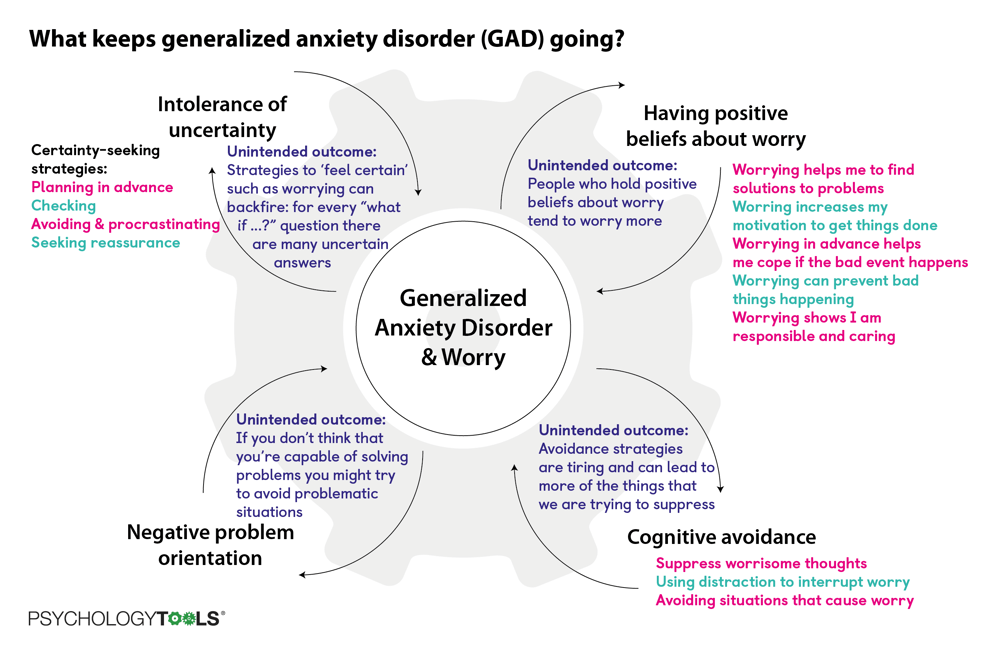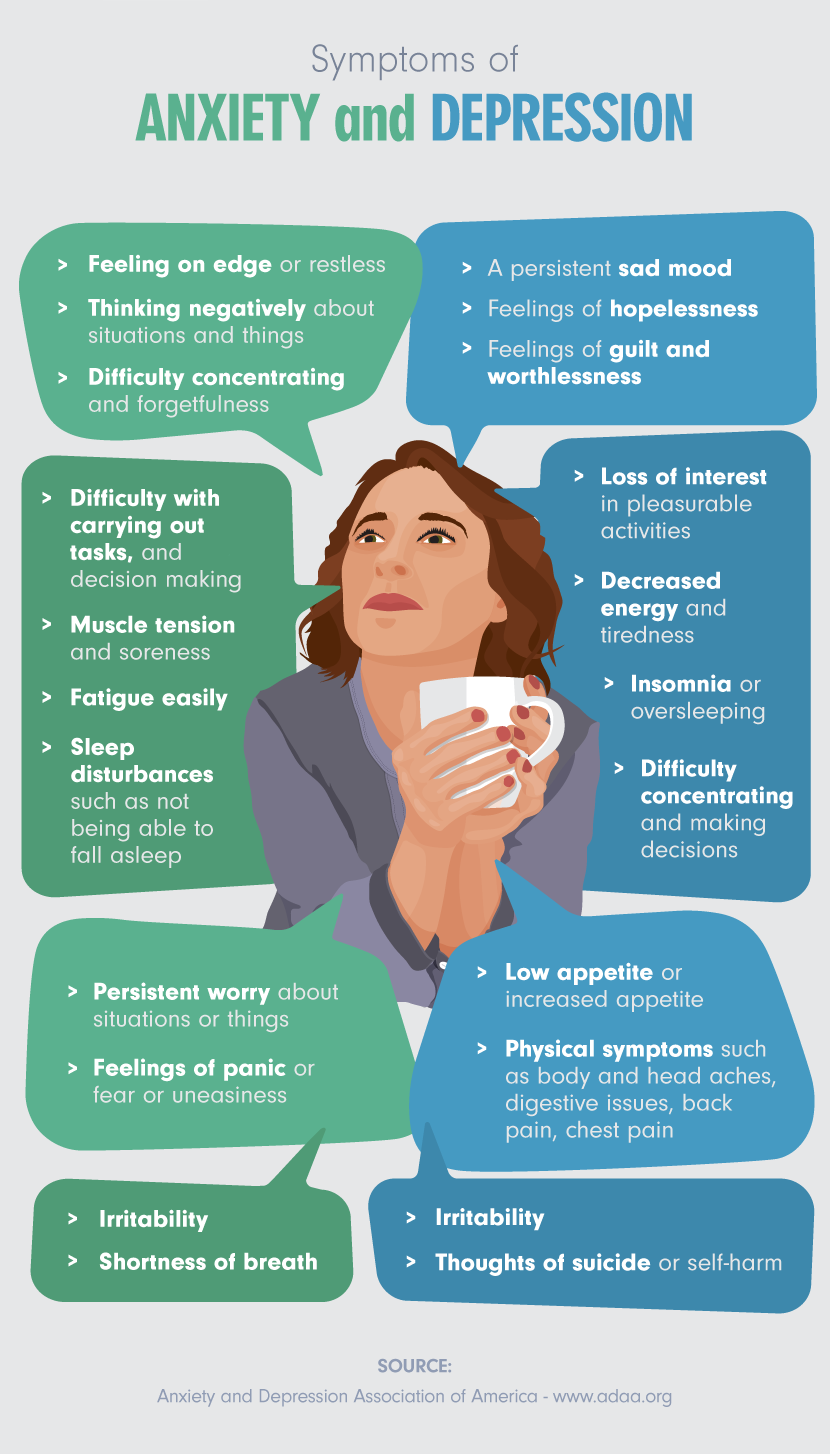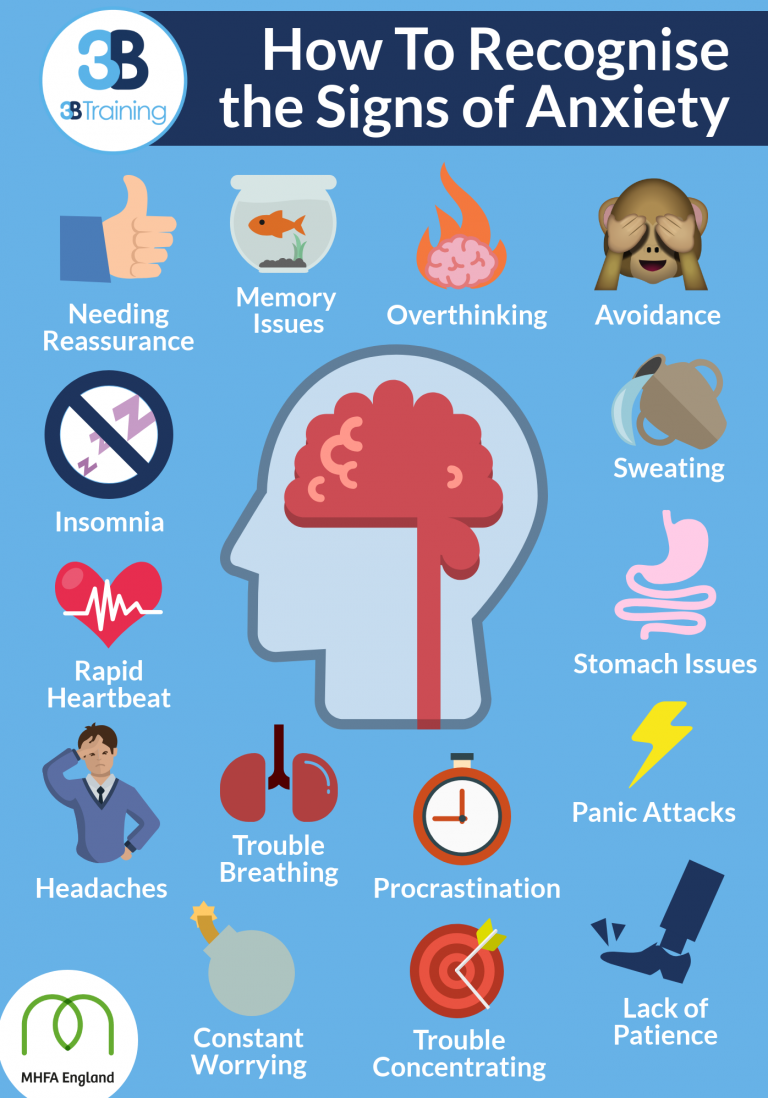How Can I Best Cope With An Anxiety Disorder
There are several steps you can take to cope with anxiety disorder symptoms. These strategies can also make your treatment more effective:
- Explore stress management: Learn ways to manage stress, such as through meditation.
- Join support groups: These groups are available in-person and online. They encourage people with anxiety disorders to share their experiences and coping strategies.
- Get educated: Learn about the specific type of anxiety disorder you have so you feel more in control. Help friends and loved ones understand the disorder as well so they can support you.
- Limit or avoid caffeine: Many people with anxiety disorder find that caffeine can worsen their symptoms.
- Talk to your healthcare provider: Your provider is your partner in your care. If you feel like treatment isnt working or have questions about your medication, contact your provider. Together, you can figure out how to best move forward.
How Does Psychotherapy Treat Anxiety Disorders
Psychotherapy, or counseling, helps you deal with your emotional response to the illness. A mental health provider talks through strategies to help you better understand and manage the disorder. Approaches include:
- Cognitive behavioral therapy is the most common type of psychotherapy used with anxiety disorders. CBT for anxiety teaches you to recognize thought patterns and behaviors that lead to troublesome feelings. You then work on changing them.
- Exposure therapy focuses on dealing with the fears behind the anxiety disorder. It helps you engage with activities or situations you may have been avoiding. Your provider may also use relaxation exercises and imagery with exposure therapy.
Break Tasks Into Small Steps
Sometimes getting better can feel overwhelming to the person affected. Encourage them to break things into manageable steps, so that gradual progress can be made.For example, if you are encouraging someone to get out of the house regularly, you could offer to go with them on walks. You might start with walking around the block slowly together at a quiet time of day, and then work on varying the time and going for longer distances.
Don’t Miss: What Is The Difference Between Stress And Anxiety
Outcomes In Relation With Selected Kinds Of Treatment
Large-scale international reviews of scientific studies have concluded that psychotherapy is effective for numerous conditions.
One line of research consistently finds that supposedly different forms of psychotherapy show similar effectiveness. According to The Handbook of Counseling Psychology: “Meta-analyses of psychotherapy studies have consistently demonstrated that there are no substantial differences in outcomes among treatments”. The handbook states that there is “little evidence to suggest that any one psychological therapy consistently outperforms any other for any specific psychological disorders. This is sometimes called the after a scene/section in Alice in Wonderland where every competitor in a race was called a winner and is given prizes”.
Further analyses seek to identify the factors that the psychotherapies have in common that seem to account for this, known as for example the quality of the therapeutic relationship, interpretation of problem, and the confrontation of painful emotions.
Outcome studies have been critiqued for being too removed from real-world practice in that they use carefully selected therapists who have been extensively trained and monitored, and patients who may be non-representative of typical patients by virtue of strict inclusionary/exclusionary criteria. Such concerns impact the of research results and the ability to generalize from them to practicing therapists.
Anxiety Disorders: An Overview

Sanne van Rooij, PhD, and Anaïs Stenson, PhD
In an anxiety-related disorder, your fear or worry does not go away and can get worse over time. It can influence your life to the extent that it can interfere with daily activities like school, work and/or relationships. Fear, stress, and anxiety are “normal feelings and experiences” but they are completely different than suffering from any of the seven diagnosable disorders plus substance-induced anxiety, obsessive-compulsive disorders, and trauma- or stressor-related disorders.
Anxiety disorders keep people from sleeping, concentrating, talking to others, or even leaving their home. Anxiety that may need treatment is often irrational, overwhelming, and disproportionate to the situation. It makes sufferers feel as though they have no control over their feelings, and it can involve severe physical symptoms like headaches, nausea, or trembling. It becomes classified as a disorder when normal anxiety becomes irrational and begins to recur and interfere with daily life.
But, as an example, what if someone will not leave their home for extended periods of time because they are afraid of being in a crowd or being reminded of a past traumatic event. That is not a “normal feeling or experience.”
If you think you might be struggling with an anxiety disorder, you’re not alone:
Don’t Miss: How Much Can Anxiety Raise Blood Pressure
Who Is At Risk From Mental Disorders
Determinants of mental health and mental disorders include not only individual attributes such as the ability to manage one’s thoughts, emotions, behaviours and interactions with others, but also social, cultural, economic, political and environmental factors such as national policies, social protection, standards of living, working conditions, and community support.
Stress, genetics, nutrition, perinatal infections and exposure to environmental hazards are also contributing factors to mental disorders.
When Is Anxiety An Illness
Occasional bouts of anxiety are entirely normal and one of the unavoidable costs of beingand stayingalive. However, sometimes worries get out of control.
They may arise for no discernible reason, or be disproportionate to the situation, or last beyond moves to solve any possible problem. Or the worry or physical symptoms prompt you to avoid situations that may trigger discomfort. Anxiety becomes a disorder when it consumes too much mental activity or interferes with activities and performance.
For more see Anxiety: Is It an Illness?
Also Check: How To Calm Chest Anxiety
Treating Children And Adolescents
Whereas specific phobias, SAD, and separation anxiety disorder are common in younger people, PDA and GAD are relatively rare. There are some randomized, placebo-controlled studies of pharmacotherapy for anxiety disorders in children and adolescents showing efficacy of sertraline, fluoxetine, and duloxetine in young patients with GAD, of venlafaxine and paroxetine in SAD, and of sertraline, fluvoxamine, and fluoxetine in mixed samples, including patients with separation anxiety disorder, GAD, and SAD. However, little is known about the value of long-term treatment. The combination of CBT and sertraline was found to be more effective than both treatment modalities alone.
For children and youths with separation anxiety disorder, several treatment studies exist. However, no controlled studies on the treatment of adults with this disorder could be traced.
There is also a paucity of treatment studies for children with selective mutism. Small studies have shown that psychotherapeutic approaches were at least better than waitlist controls., One review indicated that only two very small placebo-controlled drug studies showed efficacy of the SSRIs fluoxetine and sertraline.
Why Anxiety Is On The Rise
Anxiety is now the leading mental health problem around the world, and the incidence of anxiety is still rising, especially among youth. Increasing numbers of children and adolescents are being diagnosed with the disorder.
One often-cited reason for the general rise in anxiety is the burden of uncertainty in almost every domain of modern life, in response to an array of economic and cultural shifts. Uncertainty doesnt cause anxiety, but it provides breeding grounds for it.
Two important factors contributing to anxiety among the young are parenting practices that overprotect children and the rise of social media. Technology provides new opportunities for connecting people, but it also leads to new experiences of negative social comparison and new pathways for social exclusion.
For more see Children and Anxiety
Read Also: Are Stress And Anxiety The Same Thing
When Does Anxiety Need Treatment
While anxiety can cause distress, it is not always a medical condition.
Anxiety
When an individual faces potentially harmful or worrying triggers, feelings of anxiety are not only normal but necessary for survival.
Since the earliest days of humanity, the approach of predators and incoming danger sets off alarms in the body and allows evasive action. These alarms become noticeable in the form of a raised heartbeat, sweating, and increased sensitivity to surroundings.
The danger causes a rush of adrenalin, a hormone and chemical messenger in the brain, which in turn triggers these anxious reactions in a process called the fight-or-flight response. This prepares humans to physically confront or flee any potential threats to safety.
For many people, running from larger animals and imminent danger is a less pressing concern than it would have been for early humans. Anxieties now revolve around work, money, family life, health, and other crucial issues that demand a persons attention without necessarily requiring the fight-or-flight reaction.
The nervous feeling before an important life event or during a difficult situation is a natural echo of the original fight-or-flight reaction. It can still be essential to survival anxiety about being hit by a car when crossing the street, for example, means that a person will instinctively look both ways to avoid danger.
Anxiety disorders
Anxiety disorders now include the following diagnoses.
Possible causes include:
What Is Separation Anxiety Disorder
This condition mostly happens to children or teens, who may worry about being away from their parents. Children with separation anxiety disorder may fear that their parents will be hurt in some way or not come back as promised. It happens a lot in preschoolers. But older children and adults who experience a stressful event may have separation anxiety disorder as well.
Also Check: Is Depression And Anxiety A Mental Illness
What Are Psychological Treatments
Psychological treatments play a vital role in the treatment of people with Anxiety disorders. This type of treatment helps by giving an opportunity to talk about thoughts and feelings with a psychiatrist, psychologist or other suitably-qualified health professional in a structured way.There is a range of psychological treatments for Anxiety disorders, of which cognitive behavioural therapy is one of the most effective for managing symptoms. Other forms of psychotherapy may also be of value in dealing with related issues.
Treatment For Social Anxiety Disorder

Several types of treatment are available for social anxiety disorder. Treatment results differ from person to person. Some people only need one type of treatment. However, others may require more than one. Your healthcare provider may refer you to a mental health provider for treatment. Sometimes, primary care providers may suggest medication to treat symptoms.
Treatment options for social anxiety disorder include:
You May Like: How To Stop Bedtime Anxiety
Recovery Is Possible With Treatment
Recovery from an anxiety disorder is possible with the right treatment and support. Effective treatments for anxiety disorders may include:
- Cognitive behavioural therapy aims to change patterns of thinking, beliefs and behaviours that may trigger anxiety.
- Exposure therapy involves gradually exposing a person to situations that trigger anxiety using a fear hierarchy: this is called systematic desensitisation.
- Anxiety management and relaxation techniques for example deep muscle relaxation, meditation, breathing exercises and counselling.
- Medication this may include antidepressants and benzodiazepines.
Selective Serotonin Reuptake Inhibitors And Selective Serotonin Norepinephrine Reuptake Inhibitors
Due to their positive benefit/risk balance, selective serotonin reuptake inhibitors and selective serotonin norepinephrine reuptake inhibitors . During the first 2 weeks, adverse effects may be stronger. Initial jitteriness or an increase in anxiety symptoms may occur, which may reduce the patients’ treatment compliance. Lowering the starting dose of the antidepressants may reduce these adverse effects. A review of studies in depressed patients suggested that SNRIs may be less well tolerated than the SSRIs. However, according to clinical experience, tolerability may differ among patients, and it is also possible that an individual patient may experience less adverse effects when switched from an SSRI to an SNRI.
Some SSRIs and SNRIs are inhibitors of cytochrome P450 enzymes and hence may interact with other psychopharmacological drugs and medications for medical illnesses. After stopping treatment with an SSRI, withdrawal reactions may occur. However, these are much less frequent and severe than the withdrawal reactions observed after terminating benzodiazepine treatment. These adverse reactions may be more frequent with paroxetine than with sertraline or fluoxetine.
Don’t Miss: How To Relieve Anxiety To Sleep
Dont Be Too Hard On Yourself
Try to develop a habit of being flexible rather than over-demanding on yourself or others. Dont try too hard to be perfect in everything you do.Remember that youll never be able to control everything that happens around you, or what other people do and think, so why not accept this and concentrate on enjoying just being yourself.
How Is Anxiety Treated
Because anxiety can present in a lot of different ways, there are different types of treatments that will work for different people.
Anxiety might be treated by using one or a combination of methods which can include lifestyle changes, social support, psychological or talking therapies, or medical treatments. You can read more about the different types for treatment here.
Recommended Reading: Can You Self Diagnose Anxiety
How Generalised Anxiety Disorder Is Treated
GAD can have a significant effect on your daily life, but several different treatments are available that can ease your symptoms.
These include:
- medicine such as a type of antidepressant called selective serotonin reuptake inhibitors
With treatment, many people are able to control their anxiety levels. But some treatments may need to be continued for a long time and there may be periods when your symptoms worsen.
Recommendations For How To Incorporate Vr Into Psychiatric Care
VR is incorporated at the point in treatment when in vivo exposure would normally be administered. As an example, a typical protocol using VR for fear of flying teaches anxiety management techniques in the first four sessions and incorporates VR exposure to a virtual airport and airplane in the last four sessions. Specific equipment and training is needed to integrate VR into psychiatric practice effectively. A VR system will typically consist of a computer with two monitors, one for the providers interface in which they are constructing the exposure in real time, and another for the providers view of the patients position in the VR environment, and a head-mounted displays and a platform.
Recommended Reading: How To Calm Anxiety In The Moment
Ways To Manage Anxiety At Home
Anxiety disorders are treatable and preventable, like many other medical conditions. It is not a sign of personal weakness or failing. It will not go away by itself like a flu either. The fact that many do not seek professional help promptly or do not seek help at all suggests that we still have a long way to go to spread awareness and destigmatize anxiety disorder in Singapore. This applies to both the patients and their various social circles, including their families, friends and colleagues.
Basic Activities That Most People Are Able To Do Are Challenging For People With Mood And Anxiety Disorders

- Of people with mood and/or anxiety disorders, 27% reported that their disorder have affected their life “quite a bit” or “extremely” in the past 12 months.
- The degree to which their disorder limited their activities varied by type: activities such as recreation, leisure or hobbies were the most limited, followed by social activities with family and friends .
Figure 1: Level of difficulty experienced with basic activities by type of activity among those with mood and/or anxiety disorder, 18 years and older, Canada , 2013
The percentage of those with mood and/or anxiety disorder who reported being limited “a lot”, “a little” or “not at all” as a result of their disorder by type of activity in the past 12 months is presented in Figure 1 and in the table below.
The degree to which individuals’ disorder limited their activities varied by type of activity. Activities such as recreation, leisure or hobbies were the most limited, followed by social activities with family and friends.
| Type of activity |
|---|
Read Also: What Vitamins Are Good For Anxiety